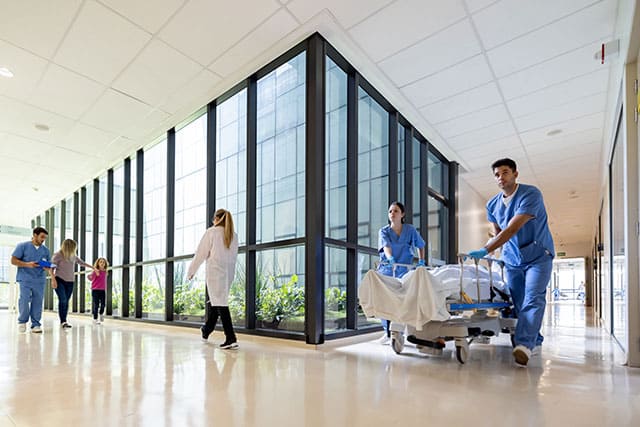Revolutionizing Healthcare with Space Management SaaS Tools
Apr 5, 2023673340c71ee5c.jpg)
How Space Management SaaS Tools Are Transforming Healthcare
The healthcare industry is continuously evolving, with new technologies and innovative solutions emerging to tackle modern challenges. One area that has seen significant advancements is space management, particularly through the adoption of Space Management SaaS (Software as a Service) tools. These cloud-based solutions offer a myriad of benefits that not only improve the efficiency of healthcare facilities but also directly impact patient care. In this blog post, we will explore how space management SaaS tools are revolutionizing patient care in healthcare organizations.
I. Enhancing Patient Flow and Reducing Wait Times
One of the primary ways space management SaaS tools can improve patient care is by optimizing patient flow within healthcare facilities. By providing real-time data and analytics on space usage, these tools enable administrators to make informed decisions on allocating resources and planning patient movement. This optimization can lead to shorter wait times for patients and a more streamlined experience, reducing patient anxiety and promoting overall satisfaction. The following are three specific ways these cloud-based solutions can contribute to more efficient patient movement and overall improved patient experience:
- Data-driven optimization of facility layout: Space management SaaS tools can provide real-time data and analytics on space usage, helping healthcare administrators make informed decisions about the optimal layout of their facilities. By analyzing factors such as patient volume, peak hours, and patterns of movement, these tools can identify bottlenecks and suggest improvements to streamline patient flow. As a result, patients can move through the facility more efficiently, leading to shorter wait times and reduced congestion.
- Coordinating resource allocation: Effective resource allocation is crucial for maintaining smooth patient flow. Space management SaaS tools can assist healthcare organizations in allocating resources such as exam rooms, equipment, and staff according to patient needs and facility capacity. By ensuring that resources are available when and where they are needed, these tools can help minimize delays and optimize patient movement through the facility.
- Integrating with appointment scheduling systems: Space management SaaS tools can often integrate seamlessly with appointment scheduling systems, enabling healthcare providers to better manage patient appointments and reduce wait times. By synchronizing appointment data with real-time information on space availability, these tools can help administrators allocate appropriate resources for each patient visit and prevent scheduling conflicts that could lead to longer wait times. Additionally, these tools can help facilities identify trends in appointment scheduling, allowing them to adjust staffing levels or operating hours to better accommodate patient needs.
II. Creating a Comfortable Environment for Patients
The effective utilization of space is crucial for creating a comfortable and patient-friendly environment. The following are three specific examples of how SaaS-based space management tools can be used to create a comfortable environment for patients.
- Data-driven optimization of waiting areas: Space management SaaS tools can provide real-time data and analytics on space usage, helping healthcare administrators to make informed decisions on the layout and design of waiting areas. By analyzing factors such as seating capacity, privacy, and accessibility, these tools can help create welcoming and comfortable waiting spaces that enhance the patient experience.
VLogicFM’s Tracking Module lets you track occupancy and traffic through different patient rooms and areas in real-time. This lets hospitals determine how spaces are being utilized, so as to optimize what it is used for and by whom (see the blog article “IoT Occupancy Sensors: The Key to Efficient Facility Space Planning”). - Streamlining treatment and consultation rooms: SaaS tools can help healthcare organizations optimize the design and utilization of treatment and consultation rooms. By analyzing space usage data, administrators can allocate enough space for medical equipment, comfortable seating for patients and their families, and ensure adequate privacy. An optimized treatment or consultation room, facilitated by space management SaaS tools, can help patients feel more relaxed and foster open communication with their healthcare providers.
More importantly, real-time, IoT-based sensors can be used by space management SaaS tools to maximize the number of rooms being utilized for patient care rather than non-clinical purposes—which decreases overall patient wait time and enhances the hospital’s overall mission. See the article “Creating SMART Buildings with IoT & IWMS” for how these sensors work with space management software. - Facilitating the creation of calming and restorative spaces: Space management SaaS tools can help healthcare facilities identify underused areas that can be repurposed into calming and restorative spaces, such as relaxation rooms or outdoor gardens. By analyzing space usage data, these tools can offer insights into the optimal layout and design for these spaces, ensuring they provide a peaceful environment for patients and their families to unwind, meditate, or take a break from the stress of medical treatments.
III. Facilitating Better Communication and Collaboration
The cloud-based nature of SaaS tools allows healthcare professionals to access information from anywhere, fostering better communication and collaboration across different locations. This seamless access to data can help healthcare providers make more informed decisions about patient care and streamline their processes. For instance, if a patient requires specialized care from another department, the staff can quickly identify available spaces and resources, ensuring the patient receives the necessary treatment without delay.
 Specifically, here are three ways that space management SaaS tools can facilitate better interactions among healthcare professionals:
Specifically, here are three ways that space management SaaS tools can facilitate better interactions among healthcare professionals:
- Remote access to data and information: One of the main advantages of cloud-based SaaS solutions is their ability to provide remote access to data and information. Healthcare professionals can access the space management platform from anywhere with an internet connection, using various devices such as computers, tablets, or smartphones. This flexibility allows for real-time collaboration, enabling team members to share insights, discuss space usage issues, and make informed decisions regardless of their physical location.
VLogicFM, for example, is accessible on any standard web browser and on mobile platforms: iOS and Android—all without the need for installing plug-ins or special software, other than the native apps on your mobile device.
- Centralized information and updates: Cloud-based space management SaaS tools can serve as a centralized hub for storing and managing information related to space usage, resource allocation, and facility planning. This centralization ensures that all team members have access to the most up-to-date information, reducing the risk of miscommunication or outdated data. By providing a single source of truth, these tools can streamline the decision-making process and foster better collaboration among healthcare professionals.
For example, you can centralize your entire facility floor plan drawings and other documents in a virtual plan room in the cloud. The VLogicFM Plan Room supports up to 70+ file formats in the cloud. All stakeholders have access to the facility drawings 24/7 from anywhere that has an internet connection. Robust access controls let managers control what floor plan drawings can be viewed and by what types of users; including temporary access users, like contractors.
- Integration with other systems: SaaS tools often feature seamless integration with other essential healthcare systems, such as electronic health records (EHRs) and building management systems. This integration allows for the smooth sharing of information across different platforms and departments, which can be crucial for coordinating patient care, resource allocation, and facility planning. When healthcare professionals have access to accurate, up-to-date information from various systems, they can collaborate more effectively and make better decisions that impact patient care and overall facility operations.
IV. Supporting Telehealth and Remote Care
Cloud-based space management SaaS solutions can play a pivotal role in supporting telehealth and remote care in healthcare organizations. Here are a couple of specific examples of how these tools can aid in the implementation and management of telehealth services:
- Identifying and allocating telehealth spaces: Space management SaaS tools can help healthcare organizations analyze their current space usage and identify underused areas that could be repurposed for telehealth services. By examining real-time data and analytics, administrators can make informed decisions on the best locations for creating dedicated telehealth consultation rooms or spaces. These tools can also assist in allocating and managing resources, such as video conferencing equipment and IT infrastructure, to support remote care effectively.
- Monitoring and optimizing telehealth spaces: Space management SaaS tools can provide ongoing monitoring and optimization of telehealth spaces, ensuring that they continue to meet the needs of patients and healthcare providers. By analyzing usage data and identifying patterns, these tools can help administrators make adjustments to the allocation and design of telehealth spaces as demand changes or new technologies emerge. This data-driven approach ensures that healthcare organizations can provide effective and accessible telehealth services in a constantly evolving landscape (also see blog article, “IoT Occupancy Sensors: The Key to Efficient Facility Space Planning”).
V. Take Away
Space management SaaS tools are revolutionizing the healthcare industry by offering innovative solutions to optimize space usage, streamline processes, and improve patient care. By adopting these tools, healthcare organizations can enhance the patient experience, reduce wait times, and provide more personalized care. In an industry where patient satisfaction is paramount, embracing space management SaaS tools can be a game-changer for healthcare facilities looking to modernize and improve their services.

